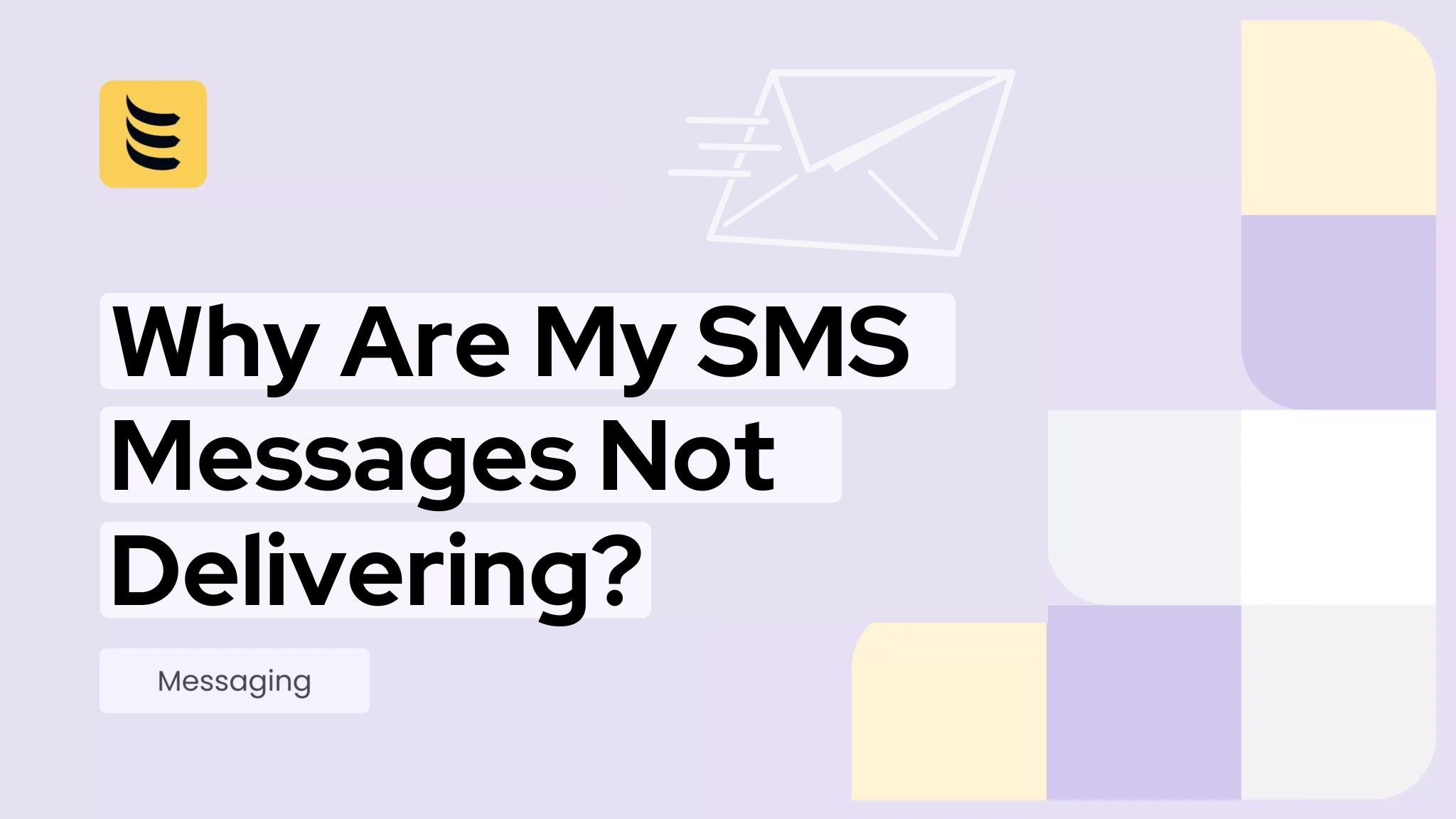Introduction
SMS messaging is one of the most direct and effective ways for businesses to engage with customers. With open rates exceeding 98% and near-instant delivery, text messages are a powerful tool for promotions, alerts, reminders, and customer support.
However, high deliverability is crucial—if your messages don’t reach customers, missed opportunities, frustrated users, and lost revenue can follow. Businesses rely on SMS for time-sensitive communications, making failed deliveries a major pain point.
Many companies face common frustrations, such as:
Customers not receiving order confirmations or OTPs.
Sudden drops in engagement despite successful past campaigns.
Messages being flagged as spam without clear reasons.
In this guide, we’ll explore why SMS messages fail to deliver and provide actionable solutions to ensure your texts reach the right audience, every time.
Carrier-Related Issues: The Hidden Roadblocks Killing Your SMS Deliverability
You hit send—but your message never arrives. No error, no warning. Just silence.
What happened?
The truth is, mobile carriers act like bouncers at an exclusive club, deciding which texts get through and which get tossed out. If your messages keep failing, carrier-related issues are likely to blame.
Let’s break down the two biggest culprits—and how to fix them.
a) Carrier Filtering & Blocking – Why Your Texts Get Marked as Spam
Carriers (like Verizon, T-Mobile, or Vodafone) use automated spam filters to protect users from unwanted messages. But sometimes, even legitimate business texts get caught in the crossfire.
How Carriers Flag Your Messages as Spam
- Content Scanning – Algorithms scan for “spammy” keywords (e.g., “FREE,” “WIN,” “ACT NOW!”).
- Volume & Speed – Sending too many messages too fast raises red flags.
- Sender Reputation – If past messages were marked as spam, future ones may be blocked.
- Unregistered Numbers – Using a personal number for business SMS? Big mistake.
Common Triggers That Get Your SMS Blocked
🚩 High volume with low engagement (e.g., blasting 10,000 texts with no replies).
🚩 Suspicious links (URL shorteners like bit.ly often get flagged).
🚩 Misleading content (e.g., “Your account is suspended!” when it’s just a promo).
🚩 Unverified sender IDs (carriers prefer registered business numbers).
How to Bypass Spam Filters
✅ Whitelist your SMS number (register for A2P 10DLC in the US).
✅ Avoid spam-trigger words (use alternatives like “exclusive” instead of “free”).
✅ Warm up new numbers (start with low volume, gradually increase).
✅ Monitor delivery reports (catch blocks before they hurt your reputation).
b) Unsupported Carrier or Network Issues – When Tech Fails You
Even if your message isn’t marked as spam, carrier limitations or technical glitches can still kill delivery.
- Regional Carrier Restrictions
- Some carriers (especially in emerging markets) block international SMS.
- Prepaid numbers may reject automated messages.
- Certain types of SMS (e.g., flash messages) aren’t supported everywhere.
- Network Outages & Congestion
- Peak traffic times (holidays, emergencies) can delay messages.
- Carrier maintenance (yes, even Verizon goes down sometimes).
- Cross-carrier delays (SMS between different networks can take longer).
How to Ensure Reliable Delivery
📶 Choose an SMS provider with direct carrier connections (fewer middlemen = fewer failures).
🌍 Check carrier compatibility before sending globally (some routes are unreliable).
⏱ Schedule messages during low-traffic hours (avoid network congestion).
🔄 Have a backup channel (email, push notifications) for critical alerts.
Compliance and Regulatory Problems: The Legal Landmines Sabotaging Your SMS Campaigns
You crafted the perfect message. Your audience is waiting. But instead of reaching inboxes, your texts vanish into a regulatory black hole.
Why? Because SMS isn’t the Wild West—it’s a tightly controlled communication channel with strict rules. Fail to follow them, and carriers will shut you down without hesitation.
Here’s how compliance failures silently kill your deliverability.
a) TCPA and A2P 10DLC Violations – When “Oops” Becomes Expensive
In the U.S., the Telephone Consumer Protection Act (TCPA) and A2P 10DLC (Application-to-Person 10-Digit Long Code) regulations exist to protect consumers from spam. Violate them, and you risk more than just blocked messages—you could face massive fines.
The Two Most Common (and Costly) Mistakes
- Lack of Proper Business Registration
- Carriers now require businesses to register their SMS numbers through A2P 10DLC.
- Unregistered numbers get throttled, blocked, or marked as spam—even if your content is clean.
- Penalties escalate for repeat offenders, including higher messaging costs or permanent bans.
- Missing Opt-In Consent
- Sending texts without explicit permission violates TCPA rules.
- Purchased lists, implied consent (e.g., “They gave us their number for support”), or pre-checked opt-in boxes don’t count.
- One complaint can trigger an audit, fines up to $1,500 per unwanted message, and carrier blacklisting.
- How to Stay Compliant (and Avoid Legal Nightmares)
- Register your business and campaign through A2P 10DLC before sending.
- Use clear, documented opt-ins (e.g., “Text JOIN to [number] to subscribe”).
- Honor opt-outs immediately—any delay risks TCPA violations.
- Keep consent records in case of disputes.
b) Number Reputation Issues – When Your Sender ID Becomes Toxic
Even if you follow every rule, a bad sender reputation can still derail your SMS efforts. Carriers track your messaging history like a credit score—and if it’s poor, they’ll block you without warning.
How Sender Reputation Gets Destroyed
- Blacklisted SMS Sender IDs
- If your number was previously used for spam (even by another company), it may already be on carrier blocklists.
- Shared short codes or recycled numbers often carry hidden penalties.
- Poor Sender Score from Past Violations
- High complaint rates (users replying “STOP” or marking texts as spam).
- Sudden spikes in message volume without warming up the number.
- Sending irrelevant or misleading content that triggers filters.
- How to Rebuild (or Protect) Your Reputation
- Check if your number is blacklisted using tools like IDT Express Spam Monitor, Twilio’s Lookup or HLR Lookup.
- Start fresh with a new, dedicated number if your current one is tainted.
- Gradually increase volume to establish trust with carriers.
- Monitor engagement metrics—low reply rates hurt your score.
The Hard Truth About Compliance
Regulations aren’t just red tape—they’re enforced with real financial and operational consequences. Ignoring them means:
- Messages blocked before they’re sent
- Fines that dwarf your SMS budget
- Permanent damage to your deliverability
The fix? Play by the rules from day one. Register properly, get airtight consent, and treat your sender reputation like gold. Because in the world of SMS, compliance isn’t optional—it’s the price of admission.
Technical Delivery Failures: When Simple Mistakes Break Your SMS
Your message is ready. Your audience is waiting. But somewhere between “send” and “delivered,” technology gets in the way.
These silent tech failures don’t trigger warnings—they just kill your messages quietly. Here’s what’s happening behind the scenes.
a) Incorrect Number Formatting – Why the Right Digits Matter
SMS is unforgiving with numbers. One wrong digit, and your message disappears into the void.
Common Pitfalls:
- Missing country codes (e.g., sending to 555-123-4567 instead of +1 555-123-4567).
- Invalid or fake numbers (carriers reject these immediately).
- Landline incompatibility (many SMS gateways can’t deliver to traditional phones).
The Fix:
- Always format numbers in E.164 international standard (e.g., +[country code][number]).
- Validate numbers before sending (use an API like Twilio Lookup).
- Filter out landlines if your SMS platform doesn’t support them.
b) SMS Gateway or API Errors – The Hidden Glitches
Even if your list is perfect, technical hiccups in your SMS platform can still fail you.
Why It Happens:
- Misconfigured API settings (wrong sender ID, incorrect encoding).
- Throttling from sending too fast (carriers limit messages per second).
- Outdated integrations (changes in carrier rules break old setups).
The Fix:
- Double-check API credentials and sender IDs.
- Implement rate limiting to avoid throttling.
- Test messages in batches before full campaigns.
Content-Related Blocking: How Your Message Itself Can Kill Delivery
You could have the cleanest contact list, perfect compliance, and a flawless technical setup—but if your message content trips spam filters, it’s game over. Carriers don’t just scan numbers and volume; they dissect the actual words and links in your texts. And if anything looks suspicious, your message gets blocked without warning.
Spam-Trigger Keywords: The Words That Make Carriers Hit Delete
Carriers and spam filters maintain massive lists of high-risk words and phrases that automatically flag messages for review. Terms like “free,” “win,” “urgent,” or “limited time”—common in marketing—often trigger these filters, even if your intent is legitimate. The algorithms don’t interpret context; they just see patterns associated with scams and phishing.
To avoid this, the best approach is to write SMS copy that’s clear, professional, and avoids hyper-aggressive sales language. Instead of “WIN A FREE PRIZE! ACT NOW!” try “Your exclusive offer is ready—claim before [date].” The meaning stays the same, but the tone is less likely to set off alarms. Testing different phrasings before large sends can help identify what gets through smoothly.
URL Shorteners and Suspicious Links: Why Carriers Don’t Trust Hidden Paths
Many businesses use URL shorteners (like bit.ly or goo.gl) to save character space, but these can backfire. Spammers frequently use them to mask malicious links, so carriers often block or flag shortened URLs by default. Even if your destination is safe, the mere presence of a shortened link can sink deliverability.
A better strategy is to use full, recognizable domains—especially those you’ve registered and whitelisted with carriers. If you must shorten links, use a branded short domain (e.g., yourbrand.link) instead of a generic one. Some SMS providers also allow domain verification, which tells carriers your links are safe, further improving trust.
Unlike email, SMS has no spam folder—messages either arrive or vanish. By keeping language natural, avoiding trigger words, and using transparent links, you ensure your texts land where they should: in your customer’s inbox, not a carrier’s blacklist.
Recipient-Side Problems: When the Issue Isn’t You—It’s Their Phone
You’ve dotted every *i*, crossed every *t*—your SMS is compliant, perfectly formatted, and carrier-approved. Yet somehow, your message still doesn’t reach its destination.
What gives?
Sometimes, the problem isn’t on your end at all. Your recipient’s phone, settings, or carrier preferences can silently block your messages without you ever knowing.
Do-Not-Disturb (DND) Preferences: When “STOP” Means Stop
Even if a customer once opted in, their preferences can change. Many users enable Do-Not-Disturb (DND) modes—either through their carrier or device settings—which automatically filter promotional messages. Worse, if they’ve previously replied “STOP” to your texts, carriers legally enforce that opt-out.
Why It Matters:
- Legal penalties apply. In the U.S., TCPA fines (up to $1,500 per violation) can stack fast if you message opted-out users.
- Carriers enforce DND globally. In countries like India, sending commercial SMS to DND-registered numbers is outright blocked.
- Silent filtering happens. Some phones (especially iPhones with “Filter Unknown Senders”) may divert your texts without notifying you or the recipient.
The Fix:
- Scrub your lists regularly—remove unsubscribed numbers immediately.
- Respect DND laws—know regional rules (e.g., India’s TRAI regulations).
- Segment audiences—only send transactional messages to DND users (where allowed).
Full Inbox or Device Issues: The Invisible Delivery Killers
You’d assume a text message takes virtually no space. But if your recipient’s phone is out of storage, too old, or misconfigured, your SMS might never show up.
How It Happens:
- Storage limits: Some phones (especially older Androids) reject messages if the inbox is full.
- Incompatible devices: Basic phones or carrier-specific firmware may not support certain SMS types (e.g., long messages or Unicode).
- Outdated software: Older OS versions sometimes fail to process newer SMS protocols.
The Fix:
- Keep messages short and simple (under 160 chars for maximum compatibility).
- For critical alerts (OTPs, appointments), use multi-channel fallbacks (email, app notifications).
- Encourage users to clear storage if they’re missing important texts.
Even perfect SMS campaigns can fail because of factors beyond your control. But by honoring opt-outs, understanding device limits, and having backup channels, you minimize the fallout. Because in messaging, what you don’t know can hurt you—but now, you’re prepared.
How to Fix & Prevent SMS Delivery Failures: Your Action Plan for Guaranteed Reach
You’ve diagnosed the problems—now let’s talk solutions. SMS delivery failures don’t have to be a recurring nightmare. With the right safeguards in place, you can ensure your messages land in inboxes, not blackholes.
Here’s your step-by-step playbook to bulletproof SMS deliverability.
1. Get Legally Compliant: Register for A2P 10DLC & Follow TCPA Rules
Think of this as your SMS business license. In the U.S., A2P 10DLC registration is no longer optional—it’s carriers’ way of verifying legitimate senders. Pair this with strict TCPA compliance (explicit opt-ins, instant opt-outs), and you’ve built trust with both regulators and carriers.
Pro Tip:
- Use separate numbers for marketing vs. transactional messages to maintain cleaner compliance boundaries.
2. Scrub Your Lists Like a Surgeon: Validation is Non-Negotiable
Even one invalid number can hurt your entire campaign. Regularly:
- Remove inactive/disconnected numbers
- Filter out landlines (unless your provider supports them)
- Immediately process opt-outs
- Verify international formats (E.164 standard)
The Result? Higher deliverability rates, lower costs from wasted sends, and better engagement metrics.
3. Content is King—But Spam Filters are the Executioners
Craft messages that pass the “carrier sniff test”:
- Avoid trigger words (free, win, urgent)
- Use full URLs (not shortened links)
- Test small batches before full campaigns
- Keep transactional and promotional content distinct
Bonus: Maintain a consistent sender ID—frequent changes raise red flags.
4. Become a Delivery Data Detective
Don’t wait for complaints to discover problems. Actively:
- Track delivery receipts for patterns
- Monitor bounce rates by carrier
- Watch for sudden drops in engagement
- Check blacklists quarterly
Catch issues early = Prevent reputation damage
5. Choose Your SMS Partner Wisely
Your provider’s infrastructure directly impacts deliverability. Demand:
- Direct carrier relationships (not just resellers)
- Real-time delivery analytics
- Compliance guidance
- Global reach with local number support
Warning Signs: Frequent throttling, lack of transparency about failures
The Ultimate SMS Delivery Checklist
✅ Registered for A2P 10DLC?
✅ Updated opt-in/out processes?
✅ Numbers validated this month?
✅ Content reviewed for spam triggers?
✅ Delivery reports being analyzed?
✅ Provider meets enterprise needs?
Implement these five practices consistently, and you’ll transform SMS from a gamble into a reliable communication channel. Because in business messaging, deliverability isn’t luck—it’s strategy.
Next Steps:
- Audit your current SMS setup against this list
- Prioritize 1-2 fixes this week
- Schedule quarterly deliverability reviews
Your messages—and your customers—are waiting.




